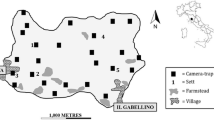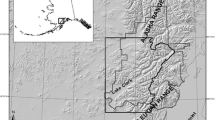Summary
Calcium intake by wild rodents varies with season and habitat. This may have important ecological consequences; several studies have suggested that calcium availability may limit growth and reproduction. We studied the effect on growth of varying the calcium intake of captive wood mice Apodemus sylvaticus (L.) and bank voles Clethrionomys glareolus (Schreber 1780). To determine whether effects observed in the laboratory could be detected in free-living animals, we also compared the body weights and lengths of free-living animals on calcium-poor gritstone areas with those of rodents on calcium-rich limestone habitats where the dietary calcium concentration was between 2 and 5 times higher. Captive wood mice fed high calcium (0.87%) diet grew at the same rate as mice fed low calcium (0.30%) diet but continued growing for longer, thereby achieving higher asymptotic weights. In contrast, captive bank voles fed the high calcium diet grew more slowly and had lower asymptotic weights than voles fed the low calcium diet. As expected from the laboratory growth study, the higher calcium intake of free-living wood mice on the limestone was associated with greater body size compared with mice on the gritstone. However, bank voles were also larger on the limestone, even though high calcium intake impaired growth in captive animals. The contrast between wood mice and bank voles in the effects of calcium on growth, the reason why impaired growth may not be apparent in bank voles from calcium-rich habitats and the ecological significance of these results are discussed.
Similar content being viewed by others
References
Alibhai SK, Gipps JHW (1985) The population dynamics of bank voles. Symp Zool Soc London 55:277–313
Anonymous (1985) Calcium: how much is too much? Nutr Rev 43:345–346
Bailey CB, Kitts WD, Wood AJ (1960) Change in the gross chemical composition of the mouse during growth in relation to the assessment of physiological age. Can J Anim Sci 40:143–155
Barkley SA, Batzli GO, Collier D (1980) Nutritional ecology of microtine rodents: a simulation model of mineral nutrition for Brown Lemmings. Oikos 34:103–114
Batzli GO (1985) The role of nutrition in population cycles of microtine rodents. Acta Zool Fenn 173:13–17
Batzli GO (1986) Nutritional ecology of the California Vole: effects of food quality on reproduction. Ecology 67:406–412
Batzli GO, Pitelka FA (1983) Nutritional ecology of microtine rodents: food habits of lemmings near Barrow Alaska. J Mammal 64:648–655
Bodansky M, Duff VB (1941) Effects of parathyroid deficiency and calcium and phosphorus of the diet on pregnant rats. J Nutr 21:179–192
Borges RM (1990) Sexual and site differences in calcium consumption by the Malabar Giant Squirrel Ratufa indica. Oecologia 85:80–86
Briese LA (1973) Variations in elemental composition and cycling in the cotton rat Sigmodon hispidus. M.Sc. thesis, University of Georgia, Athens, USA
Chitty D, Kempson DA (1949) Prebaiting small mammals and a new design of live trap. Ecology 30:536–542
Cole FR, Batzli GO (1979) Nutrition and population dynamics of the Prairie Vole Microtus ochrogaster in central Illinois. J Anim Ecol 48:455–470
Cree TC, Wadley DM, Marlett JA (1986) Effect of preventing coprophagy in the rat on neutral detergent digestibility and apparent calcium absorption. J Nutr 116:1204–1208
Draper NR, Smith H (1981) Applied regression analysis, 2nd Ed. J. Wiley & Sons, New York
Fedyk A (1974) Gross body composition in postnatal development of the bank vole. I Growth under laboratory conditions. Acta Theriol 19:381–402
Flowerdew JR (1985) The population dynamics of wood mice and yellow necked mice. Symp Zool Soc London 55:315–338
Foster DL (1988) Puberty in female sheep. In: Knobil E, Neill J (eds) The Physiology of Reproduction. Raven Press, New York, pp 1739–1762
Friedman AL, Mehls O, Kleinknecht C, Laovari D, Dodu C, Aperia A, Jackobsson B, Persson B (1986) Animal models of chronic kidney failure: influence of nutrition on growth. Am J Kidney Dis 7:335–339
Frisch RE, Revelle R (1971) Height and weight at menarche and a hypothesis of menarche. Arch Dis Child 46:695–701
Garel JM (1987) Hormonal control of calcium metabolism during the reproductive cycle in mammals. Physiol Rev 67:1–67
Gentry JB, Briese LA, Kaufman DW, Smith MH, Weiner JG (1975) Elemental flow and standing crops for small mammal populations. In: Golley FB, petrusewicz K, Ryszkowski L (eds) Small mammals: their productivity and population dynamics. Cambridge Univ. Press, Cambridge, pp 205–221
Grodzinski W (1985) Ecological energetics of bank voles and wood mice. Symp Zool Soc London 55:169–192
Gurnell J, Rennolls K (1983) Growth in field and laboratory populations of Wood Mice (Apodemus sylvaticus) J Zool London 200:355–365
Hansson L (1985) The food of bank voles, wood mice and yellownecked mice. Symp Zool Soc Lond 55:141–168
Hintz HF (1969) Coprophagy in non-ruminant herbivores. Effect of coprophagy in digestion and mineral excretion in the guinea pig. J Nutr 99:375–378
Kaufman DW, O'Farrell JO Kaufman GA Fuller SE (1976) Digestibility and elemental assimilationin cotton rats. Acta Theriol 21:147–156
Krook L, Lutwak L, McEntee K (1969) Dietary calcium, ultimobrancheal tumours and osteoporosis in the bull. Am J Clin Nutr 22:115–118
Kubik J (1965) Biomorphological variability of the population of Clethrionomys glareolus (Schreber 1780). Acta Theriol 10:117–179
McShea WJ, Madison DM (1989) Measurement of reproductive traits in a field population of meadow voles. J Mammal 70:132–141
Millar JS (1978) Energetics of reproduction in Peromyscus leucopus: the cost of lactation. Ecology 59:1055–1061
Moulton CR (1923) Age and chemical development in mammals. J Biol Chem 57:79–97
Nordin BEC (1986) Calcium. J Food Nutr 42:67–81
Pearson AM (1962) Activity pattern, energy metabolism and growth rate of the vole C. glareolus in Finland. Ann Zool Soc Vanamo 24:1–58
Pelikan J (1967) Variability of body weight in three Apodemus species. Zool Listy 16:199–220
Raczynski J (1983) Morphological variability and taxonomic differentiation. In: Petrusewicz K (ed) Ecology of the bank vole. Acta Theriol 28 Suppl 1:11–20
Sawicka-Kapusta K (1974) Changes in the gross body composition and energy value of the bank vole during their postnatal development. Acta Theriol 19:27–54
Schultz AM (1964) The nutrient-recovery hypothesis for arctic microtine cycles. II. Ecosystem variables in relation to arctic microtine cycles. In: Crisp DJ (ed) Grazing in terrestrial and marine environments. Blackwell Scientific Publications Oxford, pp 57–68
Schultz AM (1969) A study of an ecosystem: The Arctic Tundra. In: Van Dyne GM (ed) The ecosystem concept in natural resource management. Academic press, New York, pp 77–93
Sherman HS (1952) Chemistry of food and nutrition. MacMillan, New York
Shore RF (1988) Effects of variation in environmental calcium availability on wild rodent populations. Ph.D. thesis, University of Manchester, UK
Shore RF, Balment RJ, Yalden DW (1991) The effect of habitat geology on calcium intake and calcium status of wild rodents. Oecologia 88:539–546
Shore RF, Balment RJ, Yalden DW (1992) The effect of varying calcium intake on calcium metabolism in wild rodent species. J Zool London 227:29–42
Simkiss K (1967) Calcium in reproductive physiology. A comparative study of vertebrates. Van Nostrand Reinhold. New York
Snedecor GW, Cochran WG (1967) Statistical Methods 2nd ed. Iowa State Univ. Press, Iowa
Stenseth NC, Hansson L, Myllymaki A (1977) Food selection of the field vole Microtus agrestis. Oikos 29:511–524
Tadayyon B, Lutwak L (1969) Role of coprophagy and utilisation of triglycerides, calcium, magnesium and phosphorus in the rat. J Nutr 97:243–245
Walton K (1988) Environmental fluoride and fluorosis in mammals. Mammal Rev 18:77–90
West SD (1982) Dynamics of colonisation and abundance in central Alaskan populations of the Northern Red-Backed Vole Clethrionomys rutilus. J Mammal 63:128–143
Wlostowski T, Chetnicki W, Gierlachowska-Baldyga W, Chycak B (1988) Zinc, iron, copper, manganese, calcium and magnesium supply status of free-living bank voles. Acta Theriol 41:555–573
Author information
Authors and Affiliations
Rights and permissions
About this article
Cite this article
Shore, R.F., Yalden, D.W., Balment, R.J. et al. The effect of variation in calcium intake on the growth of wood mice and bank voles. Oecologia 92, 130–137 (1992). https://doi.org/10.1007/BF00317273
Received:
Accepted:
Issue Date:
DOI: https://doi.org/10.1007/BF00317273




